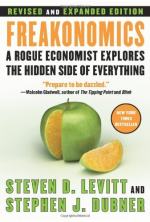
|
| Name: _________________________ | Period: ___________________ |
This test consists of 5 multiple choice questions, 5 short answer questions, and 10 short essay questions.
Multiple Choice Questions
1. Which group generally tests highest?
(a) Rural students.
(b) Urban students.
(c) Suburban students.
(d) There is no data on this topic in the text.
2. What contradictory names does Robert Lane give his two sons in the beginning of this chapter?
(a) Pretty and Ugly.
(b) Good and Bad.
(c) Winner and Loser.
(d) Hope and Despair.
3. Who was Rudolph Giuliani's police commissioner often credited with reducing crime in New York in the Nineties?
(a) Bernard Kerik.
(b) Howard Safire.
(c) William Bratton.
(d) Ray Kelly.
4. To what traditionally Jewish name did a New York Sikh change his name upon immigrating to the U.S.?
(a) Rubin.
(b) Katz.
(c) Weiner.
(d) Goldberg.
5. Which of the following factors is revealed not to have a correlative effect on a child's school performance?
(a) The child's parents are involved in the PTA.
(b) The child had a low birthweight.
(c) The child's family is intact.
(d) The child has highly educated parents.
Short Answer Questions
1. Which of the following is not an unusual name given to a child in FREAKONOMICS?
2. What is the number one white girl name that indicates low education in a parent?
3. Which of the following is not among the universities listed as names chosen by parents in California in the 1990s?
4. How did the Chicago Public School system deal with the confusion of allowing students to choose any school in the city?
5. What now-infamous governor tried to introduce a plan to mail everyone in the state a book every month from birth to kindergarten?
Short Essay Questions
1. How does Robert Lane's child-naming scheme work out?
2. Why do the authors reason that a woman who has her first child later in life will produce a higher-achieving child?
3. In what two ways do larger prisons affect less crime in a community?
4. According to Dubner and Levitt, what is the essential function of the gun?
5. What hypothetical comparison do the authors create between two boys' upbringings?
6. What connection exists between celebrity and popular names?
7. To what extent does every chapter in FREAKONOMICS involve a closed system?
8. How does Roland G. Fryer, Jr., figure into the book both as a source and a topic?
9. What policy recommendations do the authors make regarding their theories?
10. How does Ceausescu create an opposite ripple effect in Romania than what occurs in America at the same time?
|
This section contains 887 words (approx. 3 pages at 300 words per page) |

|




